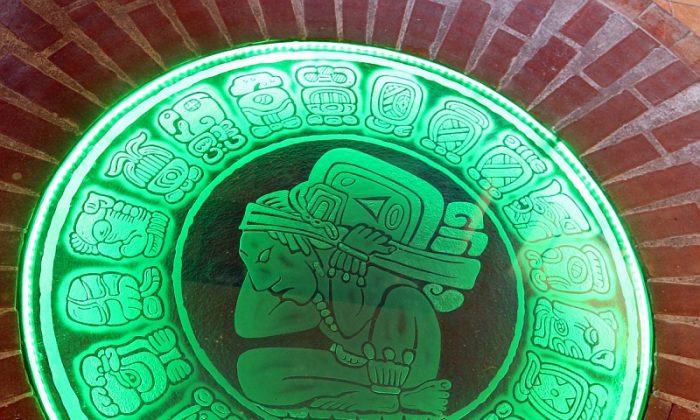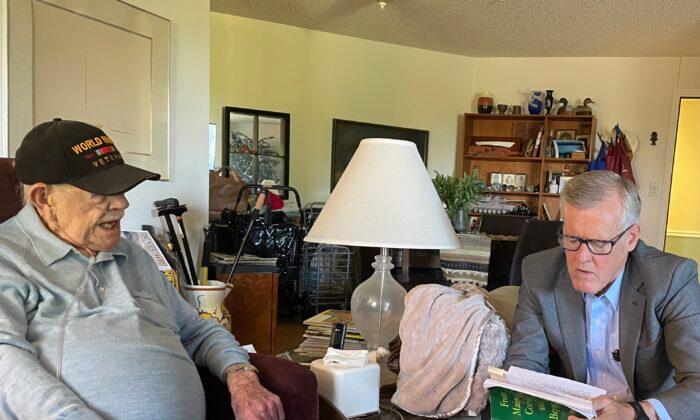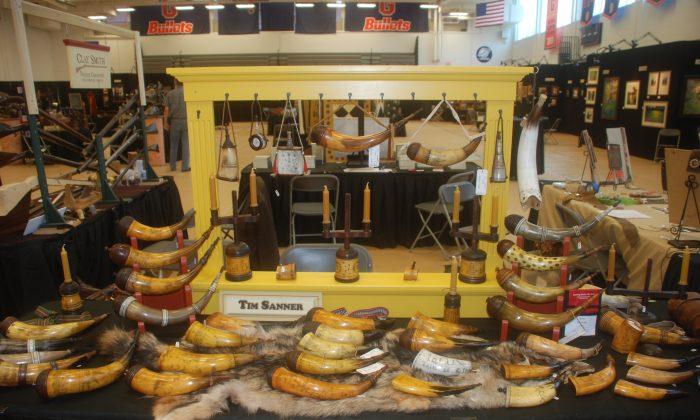Freddy Gomez unlocked a glass showcase in Casa del Jade’s main retail store in Antigua, Guatemala. Jewelry glistened in gold and platinum settings. A security guard repositioned himself to keep the doorway in view. Surveillance cameras were everywhere. With immaculate precision Freddy removed a magnificent man’s ring. The Imperial Jade stone caught the light and radiated its brilliance overpowering diamonds that surrounded it in its white gold setting. Holding the ring under the store’s projector bulbs brought the Mayan legend to life. This jade is the Stone of Kings.
“I’ve been here almost forty years,” Gerald Leech said. Gerry is the founder, owner and president of one of the world’s most important jade factories. It is one of the largest wholesale and retail outlets for the gemstone. The story of jade’s rediscovery in Guatemala is more adventurous than any fictional film could portray. The history of Mayan jade, Chinese domination of the industry and the rebirth of its tradition is told by this 71-year old Chicago native. His enthusiasm for the precious gem has not wavered since his quest began in 1974.
“I am one of four founders of modern day jade,” Gerry began his tale. It started off as an ordinary story about neighbors and friends. “My friend owned a six flat apartment building in Chicago. I had a good job as Financial Director for Hull House Social Services. Hull House was started by Jane Adams. She won the Nobel Prize in 1935. Well, in 1973 my friend Jay Ridinger’s wife Marilyn was diagnosed with cancer. I bought and was living in one of the flats in Jay’s apartment building. The family decided to travel so long as Marilyn was able and enjoy their time together. Jay bought a 27-foot long Dodge camper. It cost $27,000 back then. Luxurious. It had stereo music, beautiful.”
It was clear that Gerry’s reminiscence of his friends’ adventure remained poignant in his memory. “Jay and Marilyn decided to take their three daughters on a long trip. They started in Chicago and ended up in Antigua, Guatemala. They fell in love with Antigua,” Gerry said.
“Jay asked me to pay his bills and collect apartment rents while he was away. I said sure. In July 1973 his wife became sick and they flew back to Chicago. Marilyn died. Jay told me Antigua is so beautiful. He said he‘d like to raise his daughters there. He asked me to continue to do what I was doing for him. I said sure. Jay came back for Christmas. He was enthusiastic. He told me to come to Guatemala with him. ’We‘ll find work.’” Gerry related the story with a smile recalling events that changed his life.
They had not yet discovered the gemstone that would change their lives forever. It was the beauty of Antigua that lured Jay to return and invite his friend to join him. “I told Jay that I was still paying for my divorce and I couldn’t afford it. He made me an offer I couldn’t refuse. Jay said he'd pay for my round-trip ticket and I could stay at his house. I left in April. I stayed one week in Antigua, traveled one week around the country and went scuba diving in Roatan, in the Bay Islands of Honduras, for one week.”
If the story ended there it would be nothing more than a wonderful holiday and the beginning of a family living in the old Spanish colonial capital of Guatemala. Antigua rests in a verdant, fertile valley between mountains dominated by volcanic peaks about forty minutes from the capital.
Jay Ridinger made friends with a Belgian expatriate that had been living in Antigua since just after World War II. “Jean Devaux was a great jewelry designer. He had a God given gift for design. He was a lapidary and a jeweler. He was 60 years old at the time, a charming man. As he got to know Jay and me he made a proposal. Jean said, ‘I know where Mayan jade quarries are. I don’t have the capital or management skills to exploit it. What about starting a business together.’”
A smile crossed Gerry’s lips that radiated his good nature. “Jay said the condition was I move to Antigua an be a partner. I‘d been 8 years with Hull House. I was anxious to move on. I obtained a masters in Business Administration from the University of Chicago. Then I thought, ’What could be more interesting. A new country, a new business.' I presented my letter of resignation to Hull House on June 28, 1974.” He had the exact date down clearly in memory.
Gerry moved to Antigua and with his friends and partners, Jay Ridinger and Jean Devaux, “Got the business going. From 900 AD to 1974 nobody was doing anything commercially with jade in Guatemala. We tromped around looking for Mayan jade quarries.” He went to a glass case that displayed Mayan jade funerary pieces and removed a necklace of jade beads carved into animal shapes.
“Imagine the time it took to drill a hole in this cylinder,” Gerry said. He held a two-inch piece of jade in his fingers. “They didn’t have modern tools. Jade is among the hardest of stones. Some stones the Mayans used are not jade. They used anything that’s green. The famed Tikal mask from Tomb 160 is crysolite and serpentine…” he digressed as enthralled by the Mayan jade in the store’s museum as any first time visitor.
“We imported the equipment. We brought in raw jade. Jay met Mary Louise. Together they took a trip to the Orient in October 1974, to test the market for Guatemalan jade. When the couple came back they had one order. The conclusion was that Chinese did not like what we had at that time. We decided we'd better change course and make jewelry for visitors. Thank goodness Devaux was a jeweler and lapidary. In July 1975, we opened a retail store. It was taking off. On February 4, 1976, an earthquake struck Guatemala. After that there was no tourism. We had the only game in town. Antigua had one silversmith. I stayed until July 1976. I had an ex-wife, two kids of my own to support. Jay had three kids. We hired a caretaker. I went back to Chicago for ten months,” Gerry explained.
It was tragic. Many people in Guatemala lost their homes, thousands were killed in the earthquake and lives were disrupted. The ancient city, devastated by earthquakes in Spanish colonial times, their stately cathedrals and administration buildings in ruins, overgrown with verdant green and flowing plants, was struck once again. Antigua in 1976 was all but deserted. No tourist dollars flowed into the depressed economy.
The partners had a falling out and went their separate ways. Jay Ridinger married his girlfriend. Mary Louise, a tall, blonde blue eyed archaeologist from Texas. Together they continued to explore and research Mayan jade founding another company called Jade Maya in Antigua.
“In June 1977, I came here and opened Casa del Jade across the street from this building. I was there 21 years,” Gerry said. He began looking for a place he could buy for his expanding jade business.
“This building became available. It was after the earthquake. There was no roof, no floor between what was the first and second stories. Plants were growing in here. It was built in 1550, a legacy of Pedro Alvarado, conqueror of Guatemala. The building served as a hotel, hospital, in the 1950s it was a brothel and in the 1960s a school. The center garden here was a parking lot. We are the only private people in Antigua ever to restore a National Monument. It took 5 ½ years,” Gerry said.
The garden courtyard is resplendent with a fountain, plantings, balconies on all four sides and the Casa del Jade workshop, museum and retail store. Enlarged photographs on an outside wall depict the building as it was after the 1976 earthquake, before restoration. It is hard to imagine the undertaking, almost from scratch. Broken walls abandoned to ruin.
It is also hard to imagine the travail of the four people that pioneered jade’s rebirth in Guatemala. Jay and Mary Lou Ridinger, Jean Devaux and Gerry Leech rediscovered Mayan jade quarries and began an industry making jewelry and carvings from the ancient stone. While nephrite exists in many places around the world jadeite or true jade exists in commercial quantities only in Burma, now Myanmar, and Guatemala.
“With Imperial Jade we take what the rock will give us. We make jewelry around it,” Jerry said. He put his hands on a large boulder. A vein of dark green Imperial Jade ran through the stone.
“Without cutting it we don’t know how deep the vein is. It might only be on the surface and we get nothing. We'd like to think the rock is very valuable and we hope…” Byron Estrada said. Byron is Casa del Jade’s Manager.
“Imperial Jade is the favorite color of the Mayans. Emerald green. The color of trees, vegetation. It represented life and offered the ancient Mayans supernatural powers. They believed jade would take them from one world to the next. From the present to Xibalba, the underworld. Because it was the green of trees they thought the stone itself was alive. Everything around them was green. They made it into necklaces, bracelets, masks for kings. The funerary masks were constructed like mosaics,” Byron explained.
He opened one museum case after another. Pasqual de Paz, a master craftsman at Casa del Jade, was working on mosaic pieces for a reproduction Tikal funerary mask. Each piece had to be cut with diamond edged tools, shaped and polished. It requires weeks for a mask to be completed using modern jewelers wheels and diamond tipped cutting instruments. One can only imagine the years it required ancient Maya people to cut, drill, shape and polish jade with sand, rope and jade hand tools.
Pasqual de Paz worked with precision as he shaped the small jade stones and finished them on a polishing wheel. Each had to fit the mosaic precisely. “The masks are like a jigsaw puzzle. We believe they had a wooden base but none was found since the wood disintegrated. The masks of Palenque and Tikal were tested by researchers at the University of Pennsylvania. All the pieces were supposed to be jade. That was not the case,” Byron Estrada explained.
“Some were crysolite. Green rocks. The Mayans knew the difference between all the green stones. Of the funerary masks the lips and ears were made from Spondylus shells. Pakal was very mysterious. His sarcophagus was found in a huge pyramid 2 meters by 6 meters long. He was a tall man, 1.83 meters, more than six feet. Jade adornments were the sacred stone of the Mayans. The quality of the jade they used in funerary objects, pieces they put in the dead king’s mouth, ear pieces, are hard to find. It is different from Chinese jade. They use mostly nephrite,” Byron added.
“Nephrite comes in quantity from British Columbia in Canada. Jade is harder than nephrite. On the Mohs scale. Diamonds are hardest at 10. Nephrite is 6 to 6.5 and jadeite is 7 to 7.5,” Byron said. “It is a geological fault here in Guatemala that accounts for large deposits of jade.”
Back in the showroom Freddy Gomez enthralled shoppers with a necklace of jade. Each piece set in gold represented the colors found in Guatemala. There was a variety of blue, Cobalt Blue once favored by the Olmecs of Mexico, dark green, Imperial Green, orange, black, white, lavender, yellow, gray. The bracelet sold quickly to an American tourist for $2,454. The man’s ring with its sparkling Imperial Jade stone was priced at $5,940. Good investments considering Christie’s auction house in Hong Kong in 1997 sold an Imperial Jade necklace consisting of 27 beads for $9.3 million.
It is the ‘Stone of Kings. The Stone of Heaven.’ Jade promised eternal life to the ancients. Today’s jade pioneers have rediscovered Mayan secrets. Not without cost. “In 1984 the store was assaulted and they robbed everything. I lived through kidnappings…” Gerry Leech said.
Today this mysterious stone is treasured by Chinese and Asian cultures. It is sold in fine jewelry stores for adornment. Jade is still said to possess magical properties that are spiritual and curative. A token of good luck, jade is a symbol of eternity. Rediscovered by intrepid explorers in the mountainous jungles of Guatemala, heart of the Mayan world.
See Part II of the Investigative Series: Chinese Jade Smuggling





